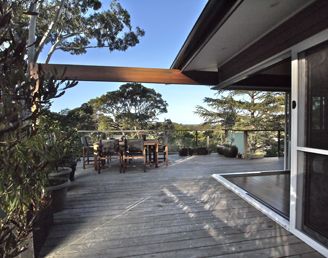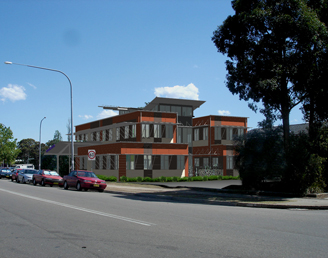The tiniest of tiny houses? – and highly mobile!
Posted by admin on 14/02/2018 at 6:31 pmAt Envirotecture we love pushing the boundaries of what’s possible. Tiny houses are the talk of the town at present, and with good reason. So what happens if you push the ‘tiny’ boundary, and add in ‘mobility’ and a goodly dash of ‘self-sufficiency’ at the same time?
Possibly you end up with a micro-motorhome! And look – here’s one we prepared earlier, under our other business banner InsideOutback Campers…


Actually, not much earlier – it has just been completed (Feb 2018) after over 12 months in production. That’s longer than many houses take to build. And the reason is – the smaller it is, the more thought has to go in to making it work efficiently: there is no room for lazy design or poor detailing. Not a cubic centimetre must be wasted! Equally, aerodynamics on the road are critical to ensure minimal fuel consumption.
And what goes up must come down. Or as this short movie demonstrates – what starts down must go up.
Light weight is another factor to be taken seriously. Here we used foam sandwich construction, to make a very stiff shell, mounted to the truck with flexible chassis connections so that neither chassis nor shell will be stressed. The interior is a mix of foam sandwich and lightweight plywood (FSC and PEFC chain of custody).

The interior has been designed to waste no space – every nook and cranny either houses a piece of equipment or is available for storage. The double bed pulls up under the roof during the day, drops down to bench height at night. That’s how we get the extra value from all available space.




A feeling of space is critical, and it’s also about being connected to the country you are in – this is a fundamental philosophy at InsideOutback. So we open it up, with large windows, for great ventilation and that sense of not ‘being inside’. Even the non-gas stove pops out of its enclosure for use outside.

One of the stand-out features of this Navara micro-motorhome is that there is no gas (yay!) and no 230v electrical (apart from an inverter) – everything except locomotion is run from 12v solar. Lightweight RAD-power panels on the roof from Solar4RVs provide 675w of power, and a big Redarc Manager-30 BMS runs a 300AH lithium-ion battery pack. Even the hot water is heated with an Australian-engineered Duetto 12v water heater. The Nissan Navara was selected as the base vehicle because in our own testing we found it to be the most fuel efficient (2.3 turbo-diesel). Needless to say, this is not a city car!
All material selections were made using these criteria:
- physical performance and service life;
- sourcing and production eco-impacts;
- human health impacts in use;
- re-use or recyclability at end of life.
Highlights of this process are:
- foam sandwich body shell pvc foam and vinyl-ester resin, glass fibre reinforcing: high eco-impact at time of construction, but long life with least weight, for best fuel economy: least-worst option;
- poly-cotton blend for canvas pop-top: moderate production impacts; robust for long life, breathable for good interior health and comfort, zero VOC off-gassing;
- interior fit-out in solid Tasmanian Oak and Has Oak veneer on hoop pine ply: FSC solids and PEFC ply, good production processes, good service life, recyclable, zero VOCs;
- flooring ComCork recycled cork and rubber hybrid: minimal production impacts, recycled content, long service life, recyclable, zero VOCs;
- head lining etc Autex Vertiface: made from recycled PET bottles, minimal production impacts, recyclable, zero VOCs;
- upholstery organic cotton 45% and hemp 55% blend: good production process, robust long life, zero VOCs.
The complete specification is shown below.
Nissan Navara NP300 DX diesel 4×4 cab chassis
Motorhome body
- ‘Insideoutback’ pop-top, foam sandwich construction shell
- Canvas Sunbrella cotton-poly composite fabric, windows mesh/clear/canvas
- Top door loose, polycarbonate clear in aluminium frame
- Roof lifter 12v linear actuator by Tomuu
- 12v electrical system:
- Redarc Manager 30 BMS
- Sino-Poly LiFePO4 lithium iron 300AH battery system with its own cell balancing BMS from Solar4RVs
- No 230v electrical built in, Redarc 12v 700w inverter (one 230v outlet)
- Solar power 5 x 135w RAD-Power lightweight PV panels on roof from Solar4RVs
- 135 litres fresh water in 3 x 316SS tanks by Hannan Stainless with individual gauges
- 12v pressure pump Flojet Triplex
- 90 litres grey water storage in 1 x 316SS tank Hannan Stainless
- Thetford cassette toilet, electric flushing
- 12v compressor fridge Evakool DC110 upright
- No gas or 230v on board
- Stove Dometic alcohol fuel no-pressure stove
- Hot water 12v Duetto Mk2
- Sink & tap Dometic SS with toughened glass lid
- Joinery solid Porta’s Tas Oak and Has Oak veneer on hoop pine ply by Bruynzeel Plywood
- Flooring Comcork Walkeasy & Aquadeck from Safety Flooring
- Lining Autex Vertiface from Solartex
- Upholstery hemp-cotton blend from Hemp Gallery
This may not be the first motorhome we’ve ever done, but was by far the most challenging. Many people and companies were involved, and we hope that the lessons learned and goals achieved here can be freely shared with anyone else wanting to do it again. Contributors to the design and construction process are acknowledged here, vaguely in chronological order:
- Certification and ADR compliance – Terry Toomey, Seven Hills NSW
- Structural design – Mark Thorpe, Mark Thorpe Boats, Warriewood NSW
- Construction advice – David Stiles, Bayview NSW
- Cab modifications – Achim, Auto Body Restorations, North Narrabeen NSW
- Structural materials – Allnex, Brookvale NSW
- Pivot beam, lifting tubes and miscellaneous parts manufacture – Marcus Engineering, Brookvale NSW
- Linear actuator – Tomuu Technology, Guangdong China
- Body finish and painting – Lone Ranger, North Narrabeen NSW
- Canvas production – Affordable Canvas, Glendenning NSW
- Interior timber – Portas, Bunnings Belrose NSW
- Interior plywood – Bruynzeel Ply, Brookvale NSW
- Flooring – Safety Flooring, Hornsby NSW
- Lining fabric – Solartex, Cromer NSW
- Cushion & mattress fabric – Hemp Gallery, Terrey Hills NSW
- Upholstery – Azuremarine, Bayview NSW
- Battery and solar power – Solar4RVs, Rowville Vic
- BMS and Inverter – Redarc, Tonsley Park SA
- Electrical parts – Keoghs Marine, Labrador Qld
- Electrical parts – Aquavolt, Roseville NSW
- Electronics installation – David Stiles, Bayview NSW
- Water tanks, stainless steel parts – Hannan Stainless Industries, Manly Vale NSW
- Caravan components – CaravansPlus, Vic
- Caravan components – Camec, Sydney NSW
Working drawings – all 90 sheets – are available for purchase, as is consulting and advice. We are not in the business of manufacturing – the purpose of this exercise is to inspire! (And maybe a tiny bit of long distance travel.)
Our other site http://www.insideoutbackcampers.com.au is here, and our Facebook page here: https://www.facebook.com/InsideoutbackCampers
Sustainable House Design
We will help you create a family home that works well, feels good, is kind to the environment, culturally appropriate and reduces your energy and running costs.
Read MoreSustainable Commercial Buildings
We design your building to help reduce your operating costs, optimize the life cycle of your building, increase your property value and increase employee productivity.
Read MoreWorking with Envirotecture
We design beautiful, sustainable buildings that work for you, your family or your business. Full range of building design, consulting and training services.
Read More






















